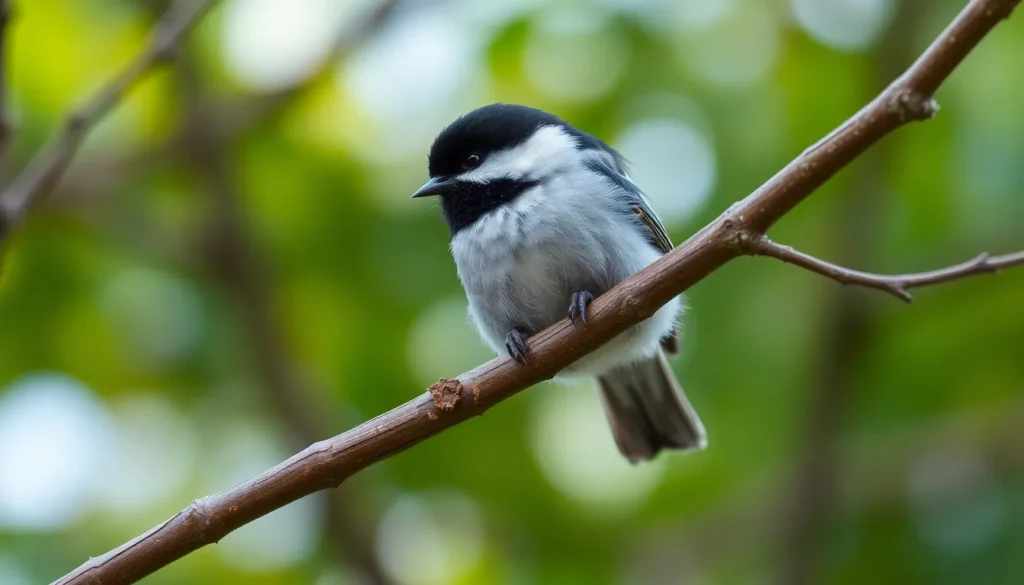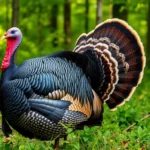We’ve all heard that distinctive “chick-a-dee-dee-dee” call echoing through our neighborhoods, but these tiny acrobatic birds offer so much more than their famous song. Chickadees are among North America’s most beloved backyard visitors, captivating us with their fearless curiosity and remarkable intelligence that rivals much larger bird species.
These pint-sized powerhouses don’t just survive harsh winters – they thrive in conditions that would challenge birds twice their size. From their incredible memory skills that help them relocate thousands of hidden food caches to their complex social hierarchies, chickadees prove that big personalities come in small packages.
Whether you’re a seasoned birder or someone who’s just noticed these charming visitors at your feeder, understanding chickadees will transform how you view your backyard network. We’re about to explore the intriguing area of these remarkable birds and discover why they’ve earned their place as one of America’s most cherished feathered friends.
Physical Characteristics of the Chickadee Bird
Chickadees possess compact yet distinctive features that make them instantly recognizable among North American songbirds. These small but robust birds showcase remarkable adaptations that help them survive in diverse climates across their range.
Size and Body Structure
Chickadees measure between 4.5 to 6 inches in length with wingspans ranging from 6 to 8 inches. Adult birds typically weigh between 0.3 to 0.5 ounces, making them among the lighter backyard visitors we encounter. Their bodies feature rounded heads proportionally larger than most songbirds of similar size.
Structural Features:
| Body Part | Measurement | Function |
|---|---|---|
| Bill Length | 0.3-0.4 inches | Seed cracking and insect capture |
| Tail Length | 2.0-2.5 inches | Balance during acrobatic feeding |
| Leg Length | 0.7-0.9 inches | Gripping branches and hanging upside down |
Wings appear short and rounded, perfectly adapted for quick maneuvers through dense vegetation. Tails extend moderately long with square tips that aid in aerial stability. Feet display strong gripping power with sharp claws that allow chickadees to hang upside down while foraging.
Distinctive Plumage and Coloring
Black caps crown chickadee heads, extending from the forehead to the nape in striking contrast. White cheek patches create the most recognizable facial pattern, bordered by the dark cap above and black bib below. Upper parts showcase gray to brownish gray coloring that varies slightly between species.
Plumage Patterns by Region:
- Back and wings: Soft gray with darker flight feathers
- Underparts: White to pale buff extending from throat to belly
- Side flanks: Warm buff or rusty coloring in some species
- Primary feathers: Dark gray with white edging
Black bibs extend from the chin down the upper throat, creating a distinctive contrast against white cheeks. Breast and belly feathers remain predominantly white or cream colored. Wing bars appear white or pale gray on darker wing coverts.
Sexual Dimorphism and Seasonal Changes
Male and female chickadees appear nearly identical to casual observers, with subtle differences requiring close examination. Males typically display slightly more pronounced black caps that extend marginally further down the nape. Female caps often appear less intense in coloration and may show brownish tinges.
Distinguishing Features:
- Male cap size: Averages 2-3mm wider than female caps
- Bib intensity: Males show deeper black throat patches
- Overall size: Males measure 3-5% larger in body length
- Behavioral cues: Males sing primary territorial songs while females produce softer calls
Seasonal plumage changes remain minimal compared to other songbird species. Fresh autumn feathers appear slightly brighter and more defined after the annual molt. Winter wear creates softer edges on cap and bib boundaries. Spring breeding season brings no dramatic color shifts, though overall condition improves with better nutrition and increased preening activity.
Different Species of Chickadee Birds
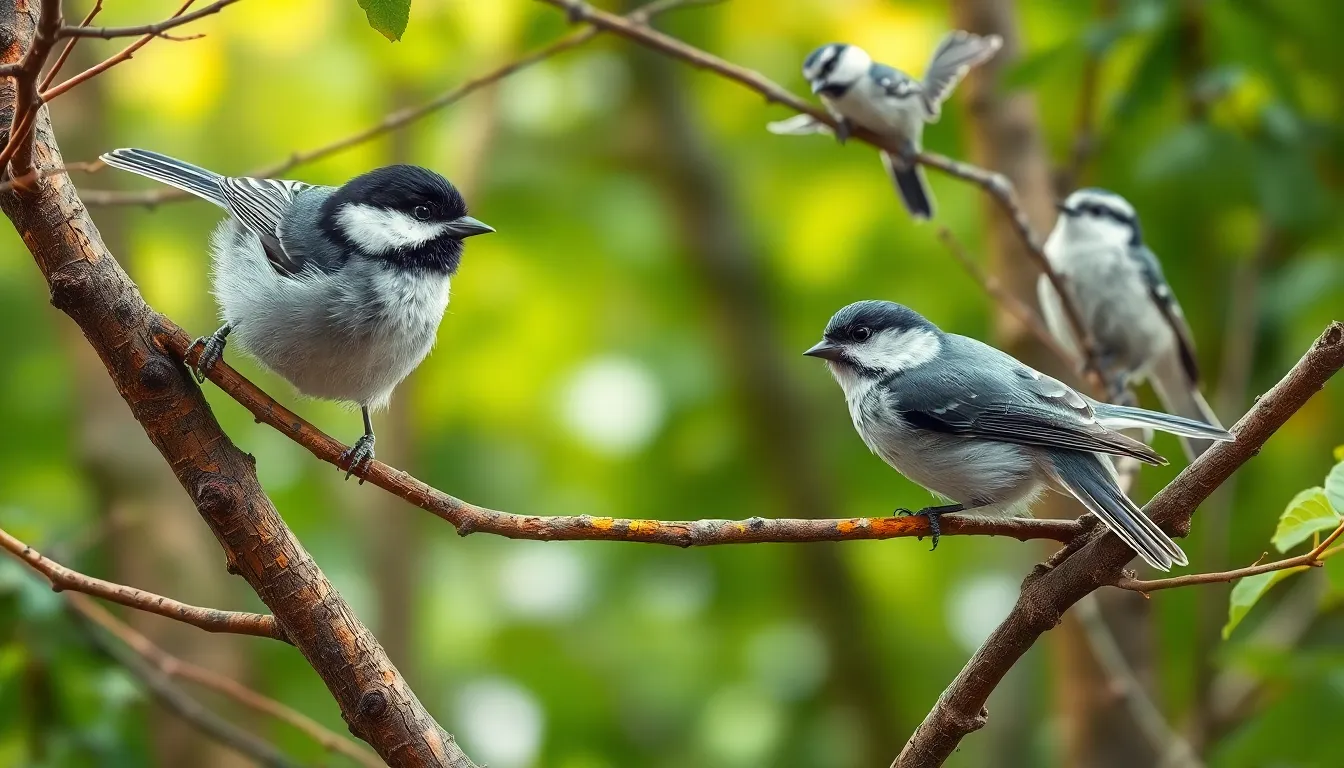
Seven distinct chickadee species inhabit North America, each adapted to exact regions and environmental conditions. We encounter these charming birds across diverse habitats from coastal forests to mountain peaks.
Black-Capped Chickadee
Black capped chickadees represent the most widespread and recognizable chickadee species across North America. These birds measure 4.75 to 5.75 inches in length and display the classic chickadee appearance with jet black caps extending below their eyes and bright white cheek patches.
Geographic distribution spans from Alaska through Canada and extends south into the northern United States including Maine, New Hampshire, Vermont, northern New York, and the Pacific Northwest. Black capped chickadees thrive in mixed and deciduous forests, parks, and suburban areas with mature trees.
Behavioral traits include their acrobatic feeding habits as they hang upside down from branches searching for insects, seeds, and berries. Their distinctive “chick-a-dee-dee-dee” call varies in complexity, with more “dee” notes indicating higher levels of threat or excitement.
Carolina Chickadee
Carolina chickadees occupy the southeastern United States from New Jersey south to Florida and west to Kansas and Texas. These birds measure slightly smaller than their northern cousins at 4.25 to 4.75 inches in length with more compact builds.
Physical differences from black capped chickadees include smaller white cheek patches, less distinct cap edges, and grayer overall coloration. Carolina chickadees prefer pine forests, mixed woodlands, and wooded suburban areas with year round mild temperatures.
Vocal distinctions set them apart through their four note whistle “fee-bee-fee-bay” compared to the two note whistle of black capped chickadees. Hybridization occurs where their ranges overlap in a narrow band across Pennsylvania, Ohio, and other border states.
Mountain Chickadee
Mountain chickadees inhabit high elevation coniferous forests throughout western North America from British Columbia to New Mexico. These specialized birds feature distinctive white eyebrow stripes above their black caps, making identification straightforward.
Elevation preferences range from 3,000 to 12,000 feet, with populations moving to lower elevations during harsh winter months. Mountain chickadees measure 5 to 5.75 inches and display longer tails relative to body size compared to other chickadee species.
Foraging behavior focuses heavily on conifer seeds, particularly those from pine, fir, and spruce trees. Their calls include a hoarse “chick-a-zee-zee-zee” that sounds raspier than other chickadee vocalizations.
Boreal Chickadee
Boreal chickadees live in the northernmost regions of North America, inhabiting spruce and fir forests across Alaska, Canada, and the northern edges of several US states including Maine, New Hampshire, Vermont, and Minnesota.
Size measurements show these birds as slightly larger than Carolina chickadees at 5 to 5.5 inches with distinctive brownish caps instead of black ones. Rich cinnamon colored flanks and brownish gray backs distinguish them from all other chickadee species.
Survival adaptations include specialized feeding techniques for extracting seeds from conifer cones and cached food storage systems that help them endure extreme northern winters. Their calls produce nasal “chick-a-day-day-day” sounds with less musical quality than southern species.
Natural Habitat and Distribution
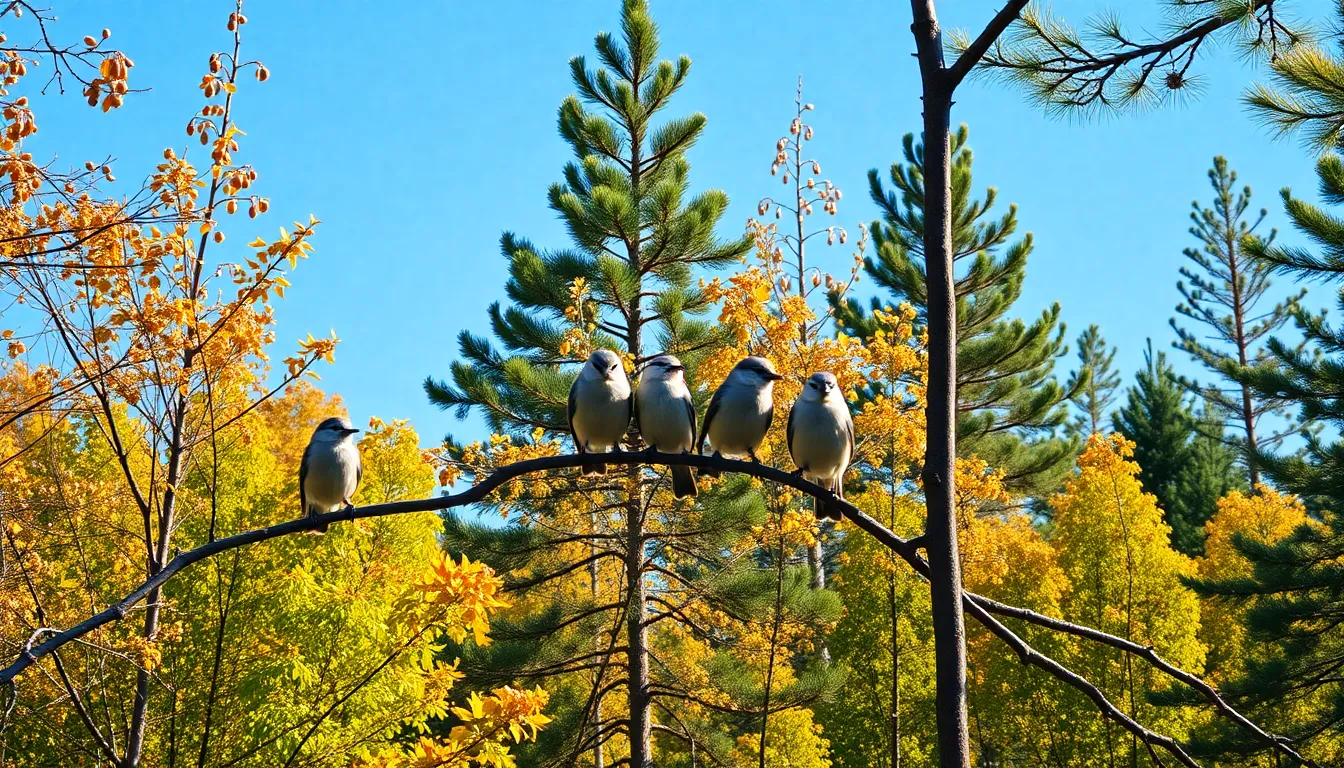
Chickadee birds occupy diverse ecosystems across North America, adapting to environments ranging from dense forests to suburban neighborhoods. These resilient songbirds demonstrate remarkable flexibility in habitat selection while maintaining exact preferences for nesting and foraging areas.
Preferred Environmental Conditions
Chickadees thrive in mixed and deciduous forests where mature trees provide abundant nesting cavities and food sources. Oak, maple, birch, and pine trees create ideal conditions for these birds, offering both insects during breeding season and seeds throughout winter months. Forest edges and woodland clearings attract chickadees because these transitional zones support diverse plant species that produce varying food resources across seasons.
Urban and suburban environments with established tree cover also support healthy chickadee populations. Parks, residential areas with native vegetation, and golf courses provide suitable habitat when they include mature trees and diverse plantings. Water sources like streams, ponds, or bird baths enhance habitat quality, though chickadees can obtain moisture from snow and dewdrops when necessary.
Elevation preferences vary among species, with Mountain Chickadees favoring altitudes between 5,000 to 12,000 feet in coniferous forests. Black Capped and Carolina Chickadees prefer lower elevations, typically below 3,000 feet, where deciduous and mixed forests predominate.
Geographic Range Across North America
| Species | Primary Range | Notable Regions |
|---|---|---|
| Black Capped Chickadee | Alaska to Newfoundland, south to northern California and New Jersey | Great Lakes region, Rocky Mountains, Pacific Northwest |
| Carolina Chickadee | Southeastern United States | Florida to Texas, north to southern Illinois |
| Mountain Chickadee | Western mountains | Sierra Nevada, Rocky Mountains, Cascade Range |
| Boreal Chickadee | Northern Canada and Alaska | Extends south to northern Minnesota and Maine |
Black Capped Chickadees claim the largest territory, spanning from coast to coast across northern North America. Their range extends from Alaska’s interior through Canada’s boreal forests down to the northern United States. These birds occupy territories as far south as northern California in the west and New Jersey along the Atlantic coast.
Carolina Chickadees dominate southeastern regions, establishing territories from eastern Texas through Florida and north to southern Illinois. The contact zone between Black Capped and Carolina Chickadees creates a narrow hybrid zone where both species interbreed, producing offspring with intermediate characteristics.
Mountain Chickadees restrict their range to western mountain systems, including the Sierra Nevada, Cascade Range, and Rocky Mountains. Boreal Chickadees inhabit the northernmost regions, preferring Canada’s spruce and fir forests while extending into Alaska’s interior and select areas of northern Minnesota, Wisconsin, and Maine.
Seasonal Migration Patterns
Most chickadee species exhibit resident behavior, remaining within established territories throughout the year rather than undertaking long distance migrations. Black Capped Chickadees demonstrate site fidelity, with breeding pairs often maintaining the same territory for multiple years. These birds may move short distances during harsh winter conditions, typically traveling less than 10 miles to locate better food sources or shelter.
Carolina Chickadees show even stronger sedentary tendencies, rarely moving more than 2 miles from their natal territories. Young birds disperse during late summer and early fall, establishing new territories within a few miles of their birthplace before winter arrives.
Mountain Chickadees display altitudinal migration patterns, moving from high elevation breeding grounds to lower elevations during winter months. These birds may descend 2,000 to 3,000 feet in elevation while remaining within the same mountain range, returning to higher elevations for spring breeding season.
Boreal Chickadees occasionally exhibit irruptive behavior during years when cone crops fail in northern forests. These irregular movements can bring flocks south of their typical range, with birds appearing in areas where they’re rarely observed during normal years.
Behavior and Social Structure
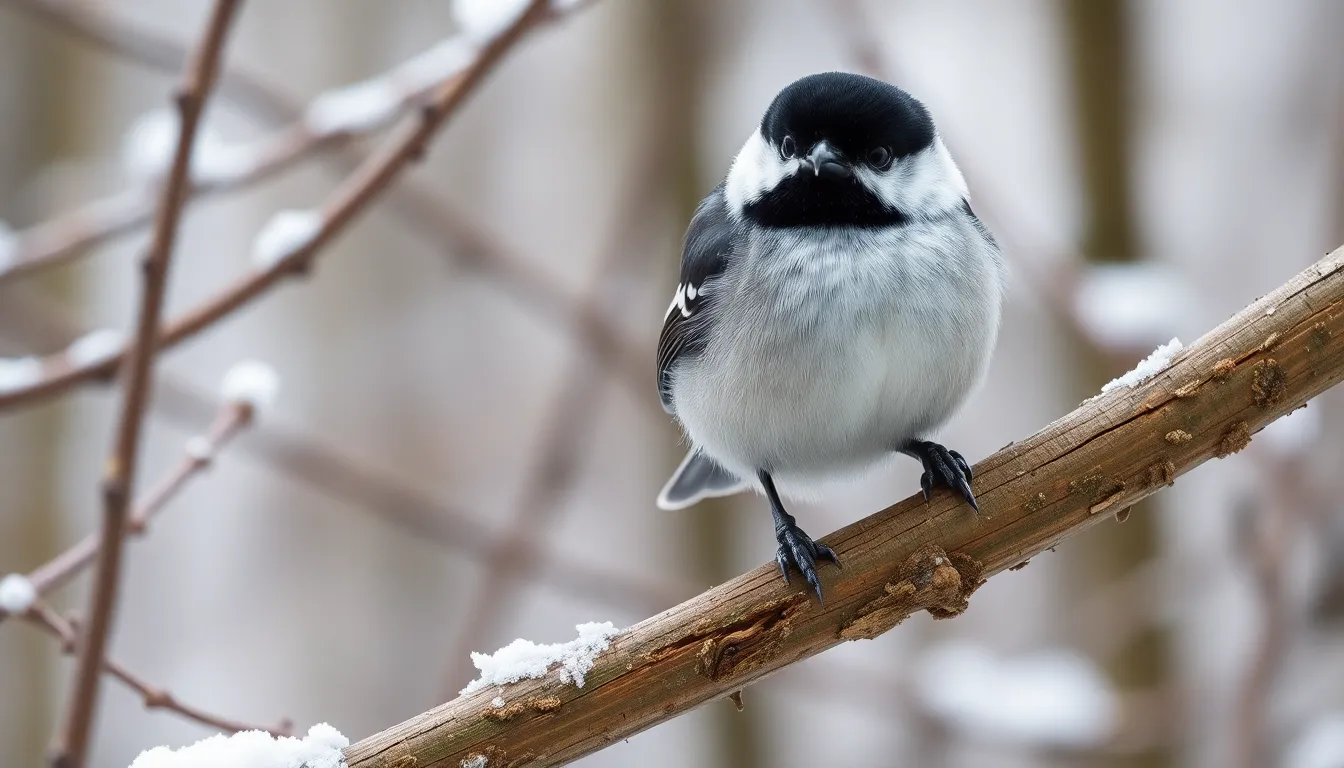
Chickadee birds demonstrate complex social behaviors that reflect their intelligence and adaptability. We observe these fascinating patterns through their feeding strategies, group dynamics, and sophisticated communication systems.
Feeding Habits and Diet
Chickadees employ acrobatic feeding techniques that distinguish them from other songbirds. We watch these birds hang upside down from branches while searching for insects, seeds, and larvae hidden in bark crevices. Black-capped chickadees consume 35% animal protein during breeding season, including caterpillars, aphids, and spider eggs.
Cache behavior defines chickadee survival strategies throughout harsh winters. We document how individual birds hide thousands of food items daily across their territories, storing sunflower seeds, suet pieces, and insect larvae in bark crevices and tree cavities. Each chickadee remembers up to 28 different cache locations within a 24-hour period.
Foraging patterns vary by season and food availability. We observe chickadees dedicating 80% of daylight hours to food-related activities during winter months. Summer foraging focuses on protein-rich insects for nestling development, while autumn emphasizes high-fat seeds for energy storage.
Flocking Behavior and Hierarchy
Mixed-species flocks form the foundation of chickadee social structure during non-breeding seasons. We identify flocks containing 6 to 15 chickadees along with nuthatches, woodpeckers, and kinglets from September through March. These associations provide enhanced predator detection and foraging efficiency benefits.
Dominance hierarchies establish clear social order within chickadee populations. We observe alpha males maintaining priority access to premium food sources and nesting sites through aggressive displays and vocalizations. Subordinate birds feed at periphery locations and defer to dominant individuals at feeding stations.
Territorial boundaries shift seasonally based on resource availability and breeding cycles. We map breeding territories averaging 8 to 10 acres per pair during spring months. Winter territories expand to cover larger areas as birds join communal roosts containing 12 to 20 individuals for warmth conservation.
Communication and Vocalizations
Chickadee vocal repertoires contain over 15 distinct calls serving exact communication functions. We recognize the iconic “chick-a-dee-dee-dee” alarm call, which increases in intensity and frequency when predators approach. Fee-bee songs establish territorial claims during breeding season with males producing 2 to 4 note variations.
Call complexity correlates directly with threat assessment and environmental conditions. We document how chickadees add extra “dee” notes when encountering smaller, more agile predators like Cooper’s hawks. Larger predators such as great horned owls trigger fewer but longer-duration alarm sequences.
Contact calls maintain flock cohesion during foraging expeditions across dense vegetation. We track how these soft chips and tseets enable separated group members to relocate each other within mixed-species flocks. Begging calls from juveniles persist for 3 to 4 weeks after fledging while parents continue feeding activities.
Nesting and Reproduction
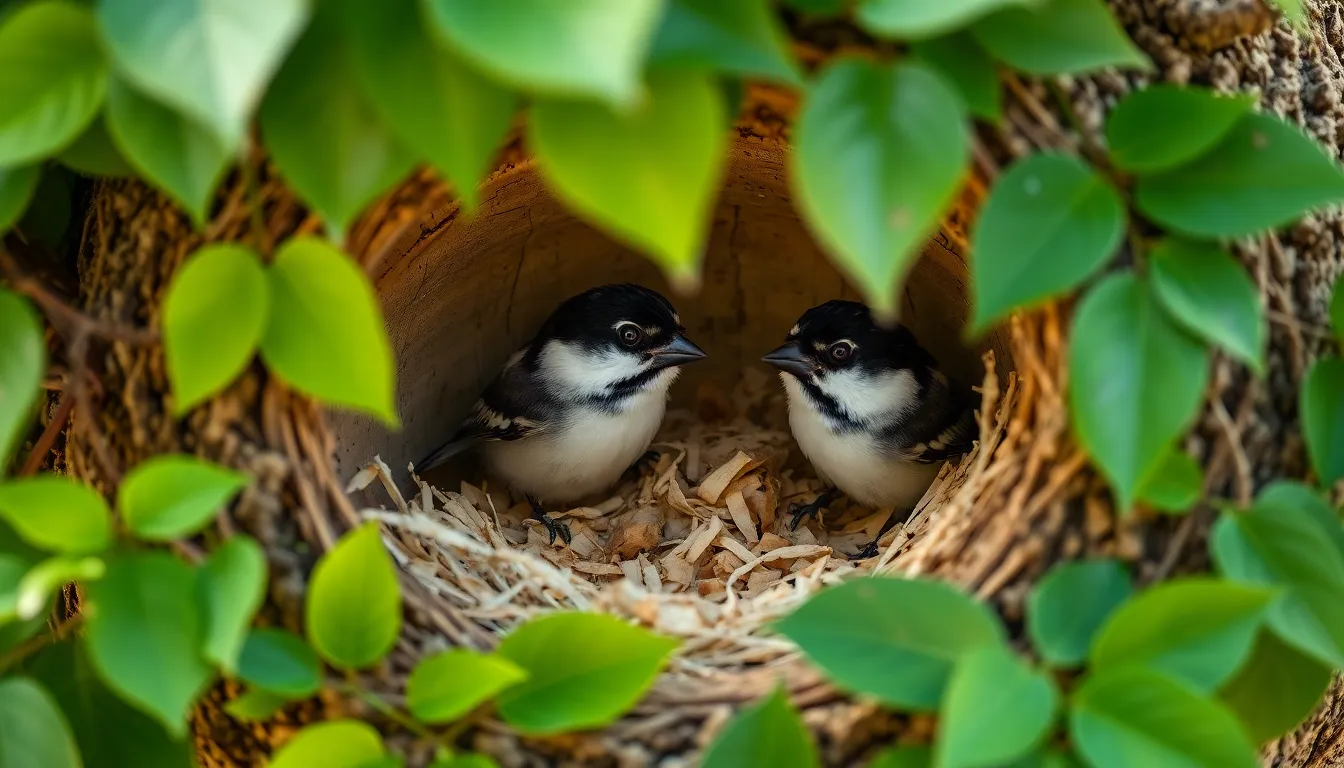
Chickadees demonstrate remarkable dedication during their breeding season, with pairs working together to create secure nesting sites and raise their young. These resilient birds time their reproductive cycles precisely with peak insect availability to maximize chick survival rates.
Breeding Season and Courtship
Breeding season begins in late April through early June for most chickadee species, though timing varies by geographic location and elevation. Males establish territories by singing their distinctive fee-bee song at dawn and dusk, marking boundaries that span 8 to 17 acres depending on habitat quality.
Courtship displays involve males presenting food gifts to potential mates, a behavior called courtship feeding that strengthens pair bonds. Females accept these offerings while performing wing quiver displays, creating a ritualized exchange that can last several weeks. Established pairs typically mate for life, returning to the same territory each breeding season.
Temperature fluctuations influence courtship timing, with pairs delaying reproduction during unseasonably cold springs. Males increase their calling frequency by 300% during peak courtship periods, advertising their fitness through vocal stamina and territory quality.
Nest Construction and Location
Chickadees excavate their own nest cavities in dead or decaying wood, a process requiring 7 to 12 days of intensive work. Both partners participate in excavation, removing wood chips one beak full at a time until they create a cavity 6 to 8 inches deep.
Preferred nesting sites include birch trees, aspen, and other soft woods at heights ranging from 4 to 15 feet above ground. Urban chickadees adapt by using fence posts, nest boxes, and even mailboxes when natural cavities become scarce. Cavity entrance holes measure exactly 1.25 inches in diameter, preventing larger birds from accessing the nest while allowing chickadee parents easy entry.
Interior construction involves lining the cavity with moss, animal fur, feathers, and plant fibers to create a soft foundation. Females complete the final nest preparation by arranging materials into a cup shape measuring approximately 3 inches across.
Egg Laying and Chick Rearing
Female chickadees lay 6 to 8 white eggs speckled with reddish brown spots, depositing one egg per day during early morning hours. Incubation lasts 11 to 13 days, with females spending 75% of daylight hours on the nest while males provide regular food deliveries.
Newly hatched chicks weigh just 0.03 ounces and remain in the nest for 14 to 18 days before fledging. Parents make 350 to 570 feeding trips per day, delivering caterpillars, spiders, and other protein rich insects to support rapid chick growth. Fledglings gain 10 times their hatching weight before leaving the nest cavity.
Post fledging care continues for 2 to 4 weeks as parents teach young birds essential survival skills including food caching techniques and predator recognition calls. Family groups remain together through late summer before juveniles disperse to establish their own territories.
Chickadee Bird Intelligence and Memory
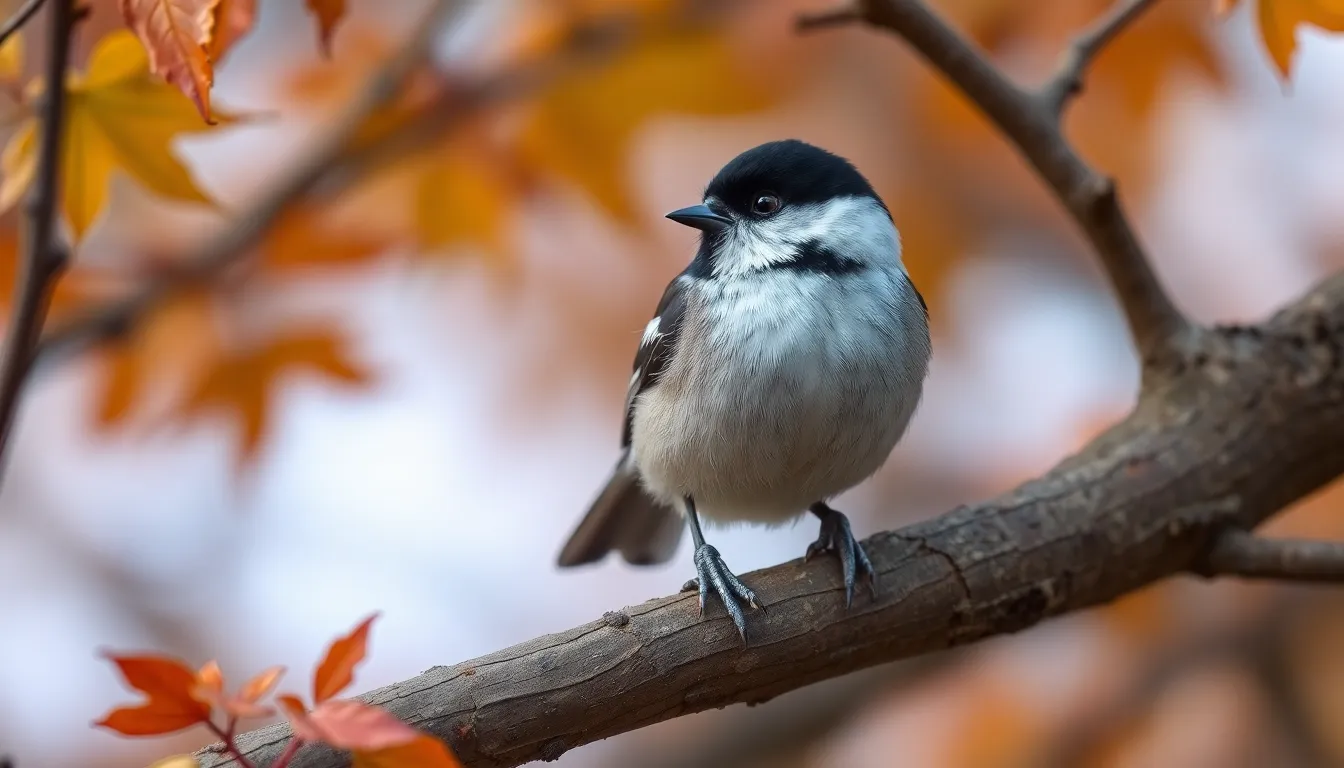
Chickadee bird intelligence ranks among the most sophisticated cognitive abilities found in small songbirds. Research reveals these compact birds possess remarkable memory capabilities that enable complex survival strategies throughout harsh winter months.
Food Caching Abilities
Chickadees cache up to 80,000 food items annually across thousands of individual hiding spots within their territories. Each bird remembers the precise location of cached seeds and insects for periods extending 2 to 4 weeks. Black-capped chickadees demonstrate the most extensive caching behaviors, storing individual sunflower seeds, pine seeds, and small insects in tree bark crevices, under lichens, and behind loose bark pieces.
The caching process involves three distinct phases: site selection, food placement, and spatial encoding. Birds evaluate potential cache sites based on accessibility, concealment from competitors, and protection from weather conditions. Memory consolidation occurs within 24 hours of caching, allowing chickadees to retrieve stored food with 85% accuracy rates even after extended time periods.
Seasonal caching patterns show peak activity during late summer and early fall when food abundance reaches maximum levels. Individual birds maintain separate mental maps for different food types, with protein-rich insects cached closer to roosting sites and seeds distributed across wider foraging areas.
Problem-Solving Skills
Chickadees solve complex foraging puzzles that require multi-step reasoning processes. Laboratory studies document their ability to navigate maze-like feeders with up to 6 sequential steps to access food rewards. These birds adapt their problem-solving approaches based on previous experiences, demonstrating flexible thinking patterns rarely observed in songbirds their size.
Innovation behaviors include using tools such as small twigs to extract insects from deep bark crevices and manipulating hinged feeder lids through coordinated foot and bill movements. Mountain chickadees show particular expertise in solving vertical puzzle feeders that mimic natural tree foraging conditions.
Social learning accelerates problem-solving acquisition among flock members. Chickadees observe successful feeding techniques demonstrated by dominant birds and incorporate these methods into their own behavioral repertoires within 2 to 3 days. Young chickadees learn complex foraging strategies through observation and practice, achieving adult-level proficiency by their first winter.
Spatial Memory Research
Scientific studies reveal chickadee hippocampus size increases by 30% during peak caching seasons compared to non-caching periods. This neuroplasticity directly correlates with enhanced spatial memory performance and cache retrieval success rates. Research conducted at universities across North America documents remarkable precision in chickadee spatial navigation abilities.
GPS tracking studies show individual chickadees maintain detailed mental maps covering territories ranging from 8 to 20 acres. Birds demonstrate accurate navigation to exact cache locations even after researchers artificially alter industry features such as fallen branches or snow accumulation. Memory accuracy decreases gradually over time, with 90% retrieval success in the first week declining to 60% after 28 days.
Comparative studies between chickadee species reveal variations in spatial memory capabilities based on habitat complexity. Mountain chickadees, handling three-dimensional forest environments, show superior spatial processing compared to their lowland counterparts. Laboratory experiments using virtual reality environments confirm these birds process spatial information through landmark recognition, geometric relationships, and magnetic compass orientation.
Role in the Ecosystem
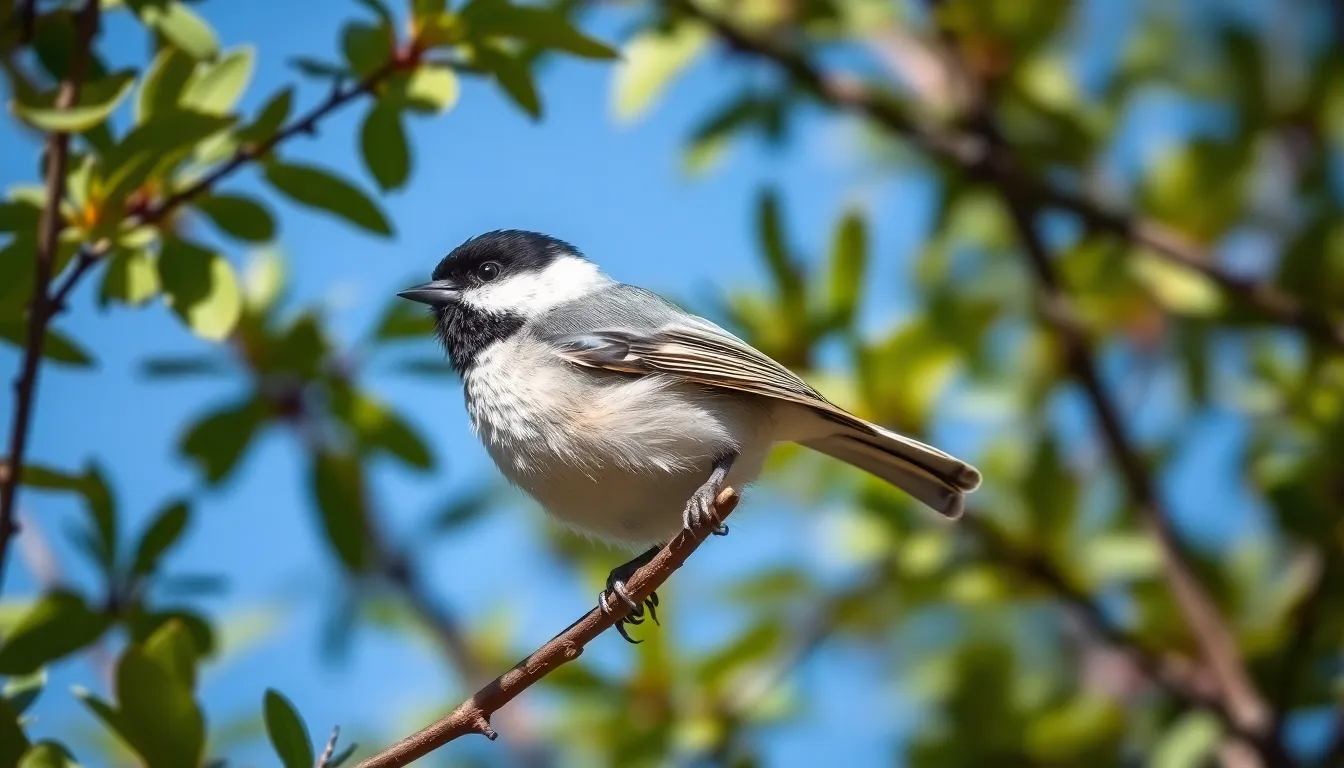
Chickadees function as essential keystone species that maintain ecological balance through multiple interconnected roles. These small songbirds provide critical network services that benefit both natural environments and human communities.
Pest Control Benefits
Chickadees consume approximately 350 to 570 insects and insect eggs daily during breeding season, making them invaluable natural pest controllers. Adult chickadees feed their nestlings exclusively insects during the first weeks of life, removing thousands of potential crop and garden pests from the environment.
Common pest species targeted by chickadees include:
- Aphids that damage agricultural crops and ornamental plants
- Caterpillars of moths and butterflies that defoliate trees
- Scale insects that weaken woody plants
- Spider mites that reduce photosynthesis in leaves
- Tent caterpillars that create unsightly webs on fruit trees
Research conducted by the USDA Forest Service demonstrates that chickadee populations can reduce insect damage to trees by 40 to 60 percent in managed forests. A single chickadee family eliminates approximately 75,000 insects during one breeding season, providing economic benefits estimated at $50 to $100 per acre in reduced pesticide costs.
Seed Dispersal Contributions
Chickadees cache approximately 58,000 to 80,000 seeds annually, creating an extensive network of potential germination sites across their territories. These birds select premium seeds from conifers, deciduous trees, and shrubs, transporting them distances of 20 to 300 meters from parent plants.
Primary seed types dispersed by chickadees include:
- Pine and spruce seeds that establish coniferous forests
- Maple and oak seeds that create hardwood stands
- Berry seeds from elderberry, serviceberry, and dogwood shrubs
- Sunflower and aster seeds that support prairie ecosystems
Forgotten cache sites become natural tree nurseries, with germination rates reaching 15 to 25 percent for cached seeds. Studies in boreal forests show that chickadee seed dispersal contributes to forest regeneration following disturbances like fires, storms, and logging operations. Mountain chickadees transport seeds to elevations 200 to 500 feet higher than parent trees, facilitating upward migration of plant communities in response to climate change.
Predator Prey Relationships
Chickadees occupy a central position in forest food webs, serving as both predators and prey species that connect multiple trophic levels. Their alarm calls alert 23 different bird species to approaching threats, creating community wide antipredator networks that benefit entire forest ecosystems.
Primary predators of chickadees include:
- Sharp shinned hawks that hunt during daylight hours
- Cooper’s hawks that specialize in capturing songbirds
- Northern shrikes that impale prey on thorns and barbs
- House cats that kill millions of songbirds annually
- Red squirrels that raid nests for eggs and nestlings
Chickadees employ sophisticated predator recognition systems, producing different alarm calls for aerial versus terrestrial threats. Their “seet” calls warn of hawks and owls, while “chick a dee dee” calls with 2 to 8 “dee” notes indicate ground predators like cats and weasels. Mixed species flocks led by chickadees increase survival rates for participating species by 18 to 23 percent through enhanced predator detection and mobbing behaviors.
Winter predation pressure shapes chickadee social structures, with dominant individuals securing access to safer foraging areas and higher quality roost sites. Population dynamics fluctuate based on predator abundance, with chickadee numbers declining 15 to 30 percent during years of high hawk populations.
Attracting Chickadees to Your Backyard
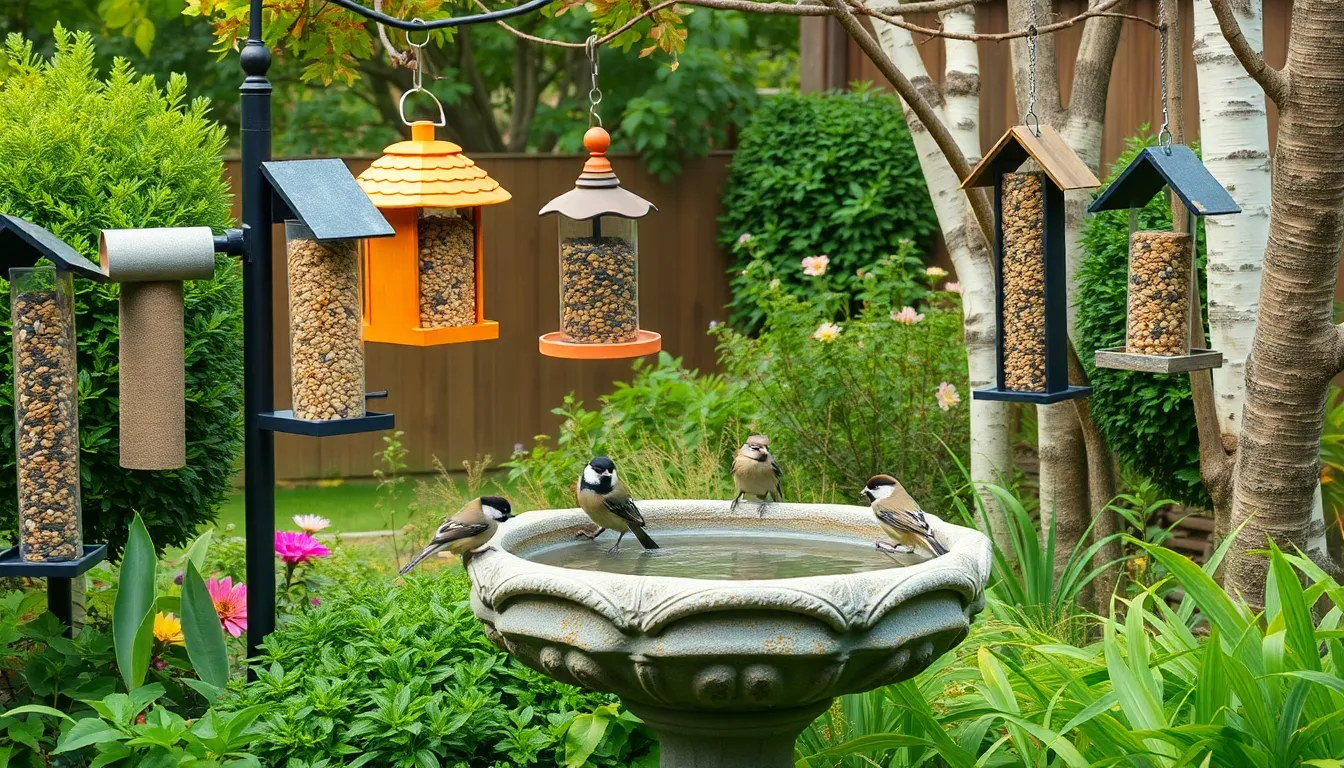
Chickadees transform ordinary backyards into vibrant ecosystems through their presence and activity. Creating an environment that appeals to these intelligent birds requires understanding their exact needs and preferences.
Best Bird Feeders and Food Types
Black oil sunflower seeds rank as the top choice for attracting chickadees to feeders. These seeds provide high fat content that supports their energy needs throughout the year. Tube feeders with metal perches accommodate their acrobatic feeding style while preventing larger birds from dominating the food source.
Suet feeders offer essential protein and fats during winter months when insect populations decline. Position these feeders 5 to 6 feet from the ground to match chickadees’ natural foraging height preferences. Platform feeders work effectively when stocked with mixed seeds including safflower seeds and nyjer.
Peanut pieces attract chickadees while discouraging squirrels who prefer whole peanuts. Store seeds in sealed containers to maintain freshness and prevent spoilage. Mealworms provide protein rich options that appeal especially to breeding pairs feeding their young.
| Feeder Type | Best Food Options | Placement Height |
|---|---|---|
| Tube feeders | Black oil sunflower seeds | 4-6 feet |
| Suet feeders | Plain suet cakes | 5-6 feet |
| Platform feeders | Mixed seeds, safflower | 3-5 feet |
| Specialty feeders | Peanut pieces, mealworms | 4-6 feet |
Creating Suitable Habitat
Native trees form the foundation of chickadee friendly habitats in backyard settings. Plant oak trees to provide natural insect populations that chickadees actively hunt throughout growing seasons. Birch trees offer excellent nesting cavities and attract insects that serve as primary food sources.
Dense shrubs create protective cover that chickadees use for roosting and escaping predators. Maintain shrub heights between 6 to 10 feet to provide optimal shelter without blocking their flight paths. Evergreen trees offer year round protection from harsh weather conditions and roosting sites during winter months.
Water sources attract chickadees when positioned at varying heights from ground level to 3 feet high. Shallow bird baths with rough surfaces provide secure footing for their small feet. Moving water features like drippers or fountains create sounds that draw chickadees from greater distances.
Nesting boxes with 1 1/8 inch entrance holes accommodate chickadee families without allowing larger cavity nesters to take over. Mount boxes 4 to 8 feet high on poles or trees facing away from prevailing winds.
Year-Round Care Tips
Winter feeding requires consistent food supplies when natural sources become scarce. Fill feeders every 2 to 3 days during cold periods when chickadees increase their daily caloric intake by 20%. High energy foods like suet and peanut butter mixtures support their metabolism during temperature drops below 20°F.
Summer maintenance involves cleaning feeders monthly with 10% bleach solution to prevent disease transmission. Remove old seeds that show signs of mold or spoilage within 48 hours of detection. Fresh water becomes crucial during hot periods when natural water sources dry up.
Predator protection includes placing feeders 10 to 12 feet from dense cover where cats might hide. Install baffles on feeder poles to prevent climbing predators from reaching food sources. Window strikes decrease when feeders sit either within 3 feet of windows or more than 30 feet away.
Consistent schedules help chickadees establish feeding routines around your backyard offerings. Early morning and late afternoon feeding times align with their natural foraging patterns. Multiple feeding stations reduce competition and allow subordinate birds access to food sources without confrontation.
Conservation Status and Threats
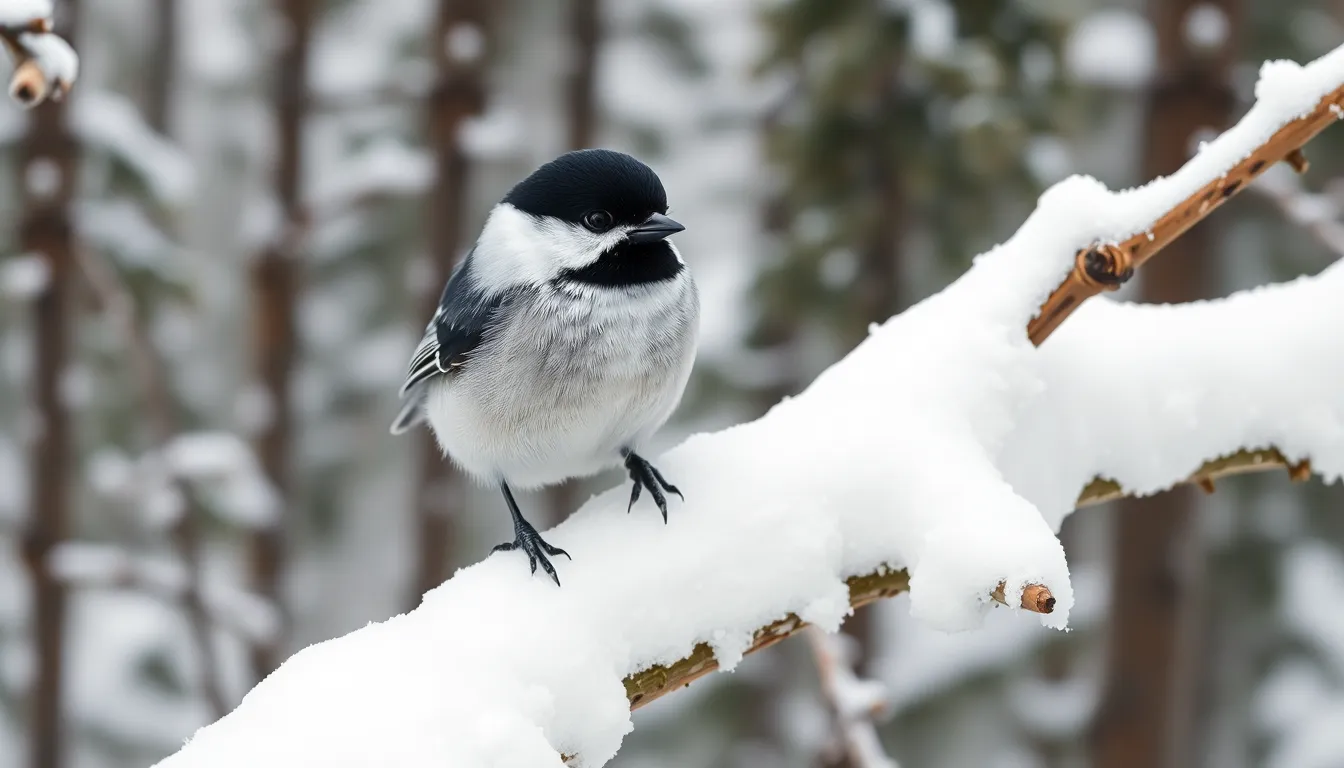
Most chickadee species maintain stable populations throughout their established ranges, with conservation organizations classifying them as species of least concern. The North American Breeding Bird Survey indicates that overall chickadee populations have remained relatively steady over the past 50 years, though regional variations exist among different species.
Black-capped Chickadees demonstrate the most robust conservation status, with populations estimated at 32 million individuals across North America. Carolina Chickadees maintain stable numbers in their southeastern range, while Mountain Chickadees face more localized pressures in high-elevation habitats. Boreal Chickadees present the greatest conservation concern, with populations showing slight declines in some northern regions.
Primary Environmental Threats
Climate change poses the most important long-term challenge to chickadee populations, particularly affecting species with limited geographic ranges. Rising temperatures alter the timing of insect emergence, creating mismatches between peak food availability and breeding seasons. Mountain Chickadees face habitat loss as warming temperatures push suitable coniferous forest zones to higher elevations.
Forest fragmentation impacts chickadee populations by reducing available nesting sites and fragmenting winter foraging territories. Urban development removes mature trees that provide natural cavities, forcing birds to compete for limited nesting opportunities. Intensive logging practices eliminate the dead trees and snags essential for cavity nesting species.
Disease and Parasitic Pressures
West Nile Virus affects chickadee populations across North America, with surveillance data showing periodic outbreaks in local bird communities. House Finch Eye Disease occasionally spreads to chickadee populations, causing conjunctivitis that impairs foraging ability. Parasitic infections from mites and lice can weaken individual birds, particularly during harsh winter months.
Salmonella outbreaks at bird feeding stations create localized population impacts when contaminated feeders spread disease through flocks. These bacterial infections spread rapidly through the close social contacts characteristic of chickadee winter flocks.
Habitat Degradation Factors
Agricultural intensification reduces insect populations that chickadees depend on for protein during breeding season. Pesticide applications eliminate arthropod prey species, forcing birds to travel greater distances for adequate nutrition. Herbicide treatments reduce native plant diversity, limiting natural seed sources that supplement chickadee diets.
Invasive plant species alter forest understory composition, reducing the native insects and seeds that chickadees evolved to exploit. European Starlings and House Sparrows compete for nesting cavities, displacing native chickadees from prime breeding sites.
Conservation Success Stories
Nest box programs provide artificial cavities that offset natural habitat losses, with some regions reporting 70% occupancy rates in properly designed boxes. Christmas Bird Count data demonstrates stable or increasing chickadee populations in areas with active habitat management programs. Urban forestry initiatives that preserve mature trees and create green corridors support healthy chickadee populations in metropolitan areas.
Citizen science projects contribute valuable monitoring data, with over 100,000 participants submitting chickadee observations annually through eBird and Project FeederWatch. These programs help researchers track population trends and identify emerging conservation challenges before they become critical.
Conclusion
These remarkable little birds continue to captivate us with their resilience and charm. Whether you’re watching them perform acrobatic feeding displays or listening to their cheerful calls on a winter morning chickadees bring joy to any outdoor experience.
By creating welcoming backyard habitats we’re not just attracting these delightful visitors – we’re supporting essential network functions. From pest control to seed dispersal chickadees play vital roles that benefit our local environments.
Supporting chickadee conservation through simple actions like maintaining clean feeders and participating in citizen science projects helps ensure future generations can enjoy these intelligent birds. Their presence serves as a reminder that nature’s smallest creatures often make the biggest impact on our daily lives.
Frequently Asked Questions
What are chickadees and where can I find them?
Chickadees are small, intelligent songbirds found throughout North America, measuring 4.5-6 inches in length. They’re easily recognizable by their distinctive black caps, white cheek patches, and gray plumage. These beloved backyard birds inhabit diverse ecosystems from dense forests to suburban neighborhoods, with seven distinct species adapted to different regions and climates.
How do I identify different chickadee species?
The Black-Capped Chickadee is the most widespread with a distinctive call and acrobatic feeding habits. Carolina Chickadees are slightly smaller with unique vocalizations, while Mountain Chickadees thrive in high-elevation coniferous forests. Boreal Chickadees live in northernmost regions and have specialized coloration. Males typically have slightly larger, darker caps than females.
Do chickadees migrate in winter?
Most chickadee species are resident birds that remain in their territories year-round. Black-Capped and Carolina Chickadees show strong site fidelity, staying put through winter. Mountain Chickadees exhibit altitudinal migration, moving to lower elevations during cold months. Boreal Chickadees occasionally migrate southward during years of severe food scarcity.
How intelligent are chickadees?
Chickadees demonstrate remarkable intelligence through their memory capabilities and problem-solving skills. They cache up to 80,000 food items annually and remember cache locations for 2-4 weeks. Their brains experience neuroplasticity, with hippocampus size increasing during peak caching seasons. They can navigate complex foraging puzzles and learn from observing other flock members.
What do chickadees eat and how do they find food?
Chickadees are omnivorous, eating insects, seeds, and berries. They employ acrobatic feeding techniques, hanging upside down to search for food. These birds cache thousands of food items to survive winter, carefully selecting sites and using spatial encoding to remember locations. They consume hundreds of insects daily, providing valuable pest control services.
How can I attract chickadees to my backyard?
Offer black oil sunflower seeds and suet in appropriate feeders placed 5-10 feet from cover. Plant native trees and shrubs to provide natural food sources and nesting sites. Maintain consistent food supplies year-round, provide fresh water sources, and install proper nesting boxes. Keep feeders clean and ensure predator protection for best results.
What role do chickadees play in the ecosystem?
Chickadees are keystone species that significantly impact their ecosystems. They provide crucial pest control by consuming hundreds of insects daily and aid forest regeneration through seed dispersal and caching. Their alarm calls enhance predator detection for mixed-species flocks, and they serve important roles in food webs as both predators and prey.
Are chickadee populations threatened?
Most chickadee species maintain stable populations, with Black-Capped Chickadees being particularly robust. However, Boreal Chickadees show slight declines in some regions. Primary threats include climate change, habitat loss, disease, and competition from invasive species. Conservation efforts like nest box programs and citizen science initiatives help support healthy populations.
How do chickadees communicate with each other?
Chickadees have sophisticated communication systems with over 15 distinct calls serving various functions. Their alarm calls vary in intensity based on predator type, and they use complex vocalizations for territory establishment and flock coordination. Each species has unique vocal patterns, with Carolina Chickadees having distinctly different calls from their Black-Capped cousins.
What makes chickadees special compared to other small birds?
Chickadees combine remarkable intelligence with fearless personalities and exceptional winter survival abilities. Their complex social structures, advanced memory capabilities, and crucial ecological roles set them apart. Despite their small size (0.3-0.5 ounces), they demonstrate sophisticated behaviors including detailed mental mapping of territories and intricate caching strategies that showcase their impressive cognitive abilities.

